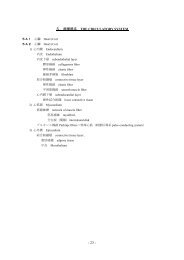Program / Abstract Book - KMU WWW3 Server for Education ...
Program / Abstract Book - KMU WWW3 Server for Education ...
Program / Abstract Book - KMU WWW3 Server for Education ...
You also want an ePaper? Increase the reach of your titles
YUMPU automatically turns print PDFs into web optimized ePapers that Google loves.
No. 67 (PF 2)<br />
The relationship between arterial wall elasticity by the phased tracking method and<br />
vascular manifestations in type 2 diabetes mellitus patients<br />
Michiaki Miyamoto 1) , Kazuhiko Kotani 1) , Hideyuki Hasegawa 2, 3) , Hiroshi Kanai 3, 2) , Harumi<br />
Koibuchi 1) , Yasutomo Fujii 1) , Kei Konno 1) , Toshiyuki Yamada 1) and Nobuyuki Taniguchi 1)<br />
1) Department of Clinical Laboratory Medicine, Jichi Medical University, Tochigi, Japan<br />
2) Graduate School of Biomedical Engineering, Tohoku University, Sendai, Japan<br />
3) Graduate School of Engineering, Tohoku University, Sendai, Japan<br />
Aim: The aim of the present study was to investigate the utility of atherosclerotic evaluation of brachial<br />
and radial arterial wall elasticity (AWE) by the phased tracking method in patients with type 2 diabetes<br />
mellitus (T2DM).<br />
Methods: This hospital-based cross-sectional study included 244 patients with T2DM(males: 61%,<br />
mean age: 60 years). The patients were classified by vascular manifestations including a history of<br />
celebrovascular disease, coronary artery disease, diabetic retinopathy and nephropathy. The smoking<br />
habits, body mass index (BMI), blood pressure (BP), hemoglobin A1c, serum low-density lipoprotein,<br />
high-density lipoprotein, triglyceride, creatinine, and brachial and radial AWE were recorded.<br />
Differences of brachial and radial AWE by the progression of vascular manifestations were analyzed.<br />
Results: A total of 121 patients had vascular manifestations (50%). In the univariate analyses, a<br />
significant correlation was detected between brachial AWE and BMI (r = 0.30), systolic BP (r = 0.41),<br />
creatinine (r = 0.19), high-density lipoprotein (r = -0.17) and triglyceride (r = 0.14). Radial AWE had a<br />
significant correlation with BMI (r = 0.38), systolic BP (r = 0.48), creatinine (r = 0.19) and triglyceride<br />
(r = 0.18). These correlations were not largely altered in patients with or without vascular<br />
manifestations. Brachial and radial AWE of patients with vascular disease were significantly higher than<br />
those of patients without vascular manifestations (brachial AWE, 791 ± 236 kPa [Pascal] and 682 ± 215<br />
kPa, p < 0.01; radial AWE, 752 ± 245 kPa and 633 ± 209 kPa, p < 0.01). Receiver operating<br />
characteristic curve of boundary value of brachial and radial AWE revealed an area under the curve to<br />
identify the patients with vascular manifestations (brachial AWE, 0.65, p



